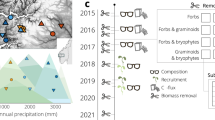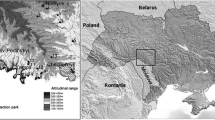Abstract
Using the small-scale gradients in light and fertility imposed by the presence of trees on Mediterranean open oak woodlands, we studied differences in the ecology, floristic diversity and species composition of an annual grassland, and modeled plant relationships with soil properties and radiation using generalized linear models. The strong intra-annual variability in the annual grassland greatly affected overall floristic diversity estimates. Therefore, sampling at least twice during the annual growing period was important to avoid underestimating floristic composition. As has been found in previous studies, different groups of grasses were clearly shaped as a response to the ecological gradient created by the influence of the tree. However, when analyzing specific relationships, only a few individual species directly responded to the studied soil and light availability factors analyzed. Among them, those species considered ‘ruderal’ such as Carduus tenuiflorus, Echium plantagineum, Lolium rigidum, Rumex bucephalophorus, and Tolpis barbata showed a clear response to some nutrients and to light availability but displayed no relationship to N soil content. Our results suggest that individual species are responding to a combination of ecological factors. Therefore, some of the generally accepted assumptions regarding the ecology of specific taxa may not be as straightforward as traditionally considered.






Similar content being viewed by others
References
Austin MP, Williams OB, Belbin L (1985) Grassland dynamics under sheep grazing in an Australian Mediterranean type climate. Vegetatio 47:201–211
Belsky AJ (1994) Influences of trees on savanna productivity: tests of shade nutrients and tree-grass competition. Ecology 75:922–932
Brooker RW, Maestre FT, Callaway RM, Lortie CL, Cavieres LA, Kunstler G, Liancourt P, Tielbörger K, Travis JMJ, Anthelme F, Armas C, Coll L, Corcket E, Delzon S, Forey E, Kikvidze Z, Olofsson J, Pugnaire F, Quiroz CL, Saccone P, Schiffers K, Seifan M, Touzard B, Michalet R (2008) Facilitation in plant communities: the past the present and the future. J Ecol 96:18–34
Callaway RM, Walker LR (1997) Competition and facilitation: a synthetic approach to interactions in plant communities. Ecology 78(7):1958–1965
de Miguel JM, Ramírez-Sanz L, Castro I, Costa-Tenorio M, Casado MA, Pineda FD (2005) Plant species richness and spatial organization at different small scales in western Mediterranean landscapes. Plant Ecol 176:185–194
Diggle PJ, Heagerty P, Liang K-Y, Zeger SL (2002) Analysis of longitudinal data. Oxford University Press, Oxford
Frazer GW, Canham CD, Lertzman KP (1999) Gap Light Analyzer (GLA): imaging software to extract canopy structure and gap light transmission indices from truecolour fisheye photographs users manual and program documentation. Simon Fraser University Burnaby BC and the Institute of Ecosystem Studies, Millbrook
Gallardo A (2003) Effect of tree canopy on the spatial distribution of soil nutrients in a Mediterranean Dehesa. Pedobiologia 47:117–125
Gallardo A, Rodríguez-Saucedo JJ, Covelo F, Fernández Alés R (2000) Soil nitrogen heterogeneity in a Dehesa ecosystem. Plant Soil 222:71–82
Gea-Izquierdo G, Sasha G, Bartolome JW (2007) Assessing plant-nutrient relationships in highly invaded Californian grasslands using non-normal probability distributions. Appl Veg Sci 10:343–350
Gea-Izquierdo G, Montero G, Cañellas I (2009) Changes in limiting resources determine spatio-temporal variability in tree–grass interactions. Agrofor Syst 76:375–387
Gea-Izquierdo G, Allen-Diaz B, San Miguel-Ayanz A, Cañellas I (2010) How do trees affect spatio-temporal heterogeneity of nutrient cycling in Mediterranean annual grassland? Ann For Sci 67:112
González Bernáldez F, Morey M, Velasco F (1969) Influences of Quercus ilex rotundifolia on the herb layer at the El Pardo forest (Madrid). Boletín de la Real Soc Española de Historia Nat (Biol) 67:265–284
González Ponce R, Sentín Montoya I (2007) Effect of nitrogen fertilization schedule and herbicide on competition between barley and ryegrass. J Plant Nutr 30:783–794
Gross KL, Mittelbach GG, Reynolds HL (2005) Grassland invisibility and diversity: responses to nutrients seed input and disturbance. Ecology 86(2):476–486
Guisan A, Edwards TC Jr, Hastie T (2002) Generalized linear and generalized additive models in studies of species distributions: setting the scene. Ecol Model 157:89–100
Hacker SD, Gaines SD (1997) Some implications of direct positive interactions for community species diversity. Ecology 78:1990–2003
Huenneke LF, Mooney HA (1989) Grassland structure and function: California annual grassland. Kluwer, London
Legendre P, Legendre L (1998) Numerical ecology. Elsevier Science BV, Amsterdam
Mamolos AP, Veresoglou DS, Barbayiannis N (1995) Plant species abundance and tissue concentrations of limiting nutrients in low-nutrient grasslands: a test of competition theory. J Ecol 83(3):485–495
Marañón T (1985) Diversidad florística y heterogeneidad ambiental en una dehesa de Sierra Morena. Anal de Edafol y Agrobiol XLIV(7-8):1183–1197
Marañón T (1986) Plant species richness and canopy effect in the savanna-like “dehesa” of S.W. Spain. Ecol Mediterr XII(1–2):131–141
Martínez-Turanzas GA, Coffin DP, Burke IC (1997) Development of microtopography in a semi-arid grassland: effects of disturbance size and soil texture. Plant Soil 191:163–171
McCullagh P, Nelder JA (1989) Generalized linear models. Chapman & Hall, London
McCune B, Mefford MJ (1999) PC-ORD. Multivariate analysis of ecological data. MjM Software Design, Gleneden Beach, OR
Molenberghs G, Verbeke G (2005) Models for discrete longitudinal data, 1st edn. Springer Berlin Heidelberg, New York, NY
Montalvo J, Casado MA, Levassor C, Pineda FD (1993) Species diversity patterns in Mediterranean grasslands. J Veg Sci 4:213–222
Narwal S, Sindel BM, Jessop RS (2008) Dormancy and longevity of annual ryegrass (Lolium rigidum) as affected by soil type depth rainfall and duration of burial. Plant Soil 310:225–234
Olea L, San Miguel-Ayanz A (2006) The Spanish dehesa: a traditional Mediterranean silvopastoral system linking production and nature conservation. Grassl Sci Eur 11:3–13
Peco B (1989) Modelling Mediterranean pasture dynamics. Vegetatio 83:269–276
Reynolds HL, Hungate BA, Chapin FS III, D’Antonio C (1997) Soil heterogeneity and plant competition in an annual grassland. Ecology 78(7):2076–2090
Rhoades CC (1997) Single-tree influences on soil properties in agroforestry: lessons from natural forest and savanna ecosystems. Agrofor Syst 35:71–94
Rivas-Martínez S, Rivas-Saenz S (2010) Worldwide bioclimatic classification system 1996–2009. Phytosociological Research Center, Spain. http://www.globalbioclimatics.org. Accessed 10 April 2010
San Miguel-Ayanz A (2001) Pastos naturales españoles. Mundi-Prensa-Fundación Conde del Valle de Salazar, Madrid
SAS Institute Inc. (2002) SAS/STAT® 9.0 User’s Guide. SAS Institute Inc., Cary, NC
Scholes R, Archer SR (1997) Tree-grass interactions in savannas. Annu Rev Ecol Syst 28:517–544
van Andel J, Vera F (1997) Reproductive allocation in Senecio sylvaticus and Chamaenerion angustifolium in relation to mineral nutrition. J Ecol 65:747–758
Westhoff W, van der Maarel E (1978) The Braun-Blanquet approach. In: Whittaker RH (ed) Classification of plant communities. Junk, The Hague
Whittaker RJ, Willis KJ, Field R (2001) Scale and species richness: towards a general hierarchical theory of species diversity. J Biogeogr 28:453–470
Acknowledgments
We are very grateful to the “Dehesón del Encinar” and Celia López-Carrasco for their help in setting up the plots, to Agustín Rubio Sánchez for his help with methodology and to the three anonymous reviewers for their comments.
Author information
Authors and Affiliations
Corresponding author
Electronic supplementary material
Below is the link to the electronic supplementary material.
Rights and permissions
About this article
Cite this article
Fernández-Moya, J., San Miguel-Ayanz, A., Cañellas, I. et al. Variability in Mediterranean annual grassland diversity driven by small-scale changes in fertility and radiation. Plant Ecol 212, 865–877 (2011). https://doi.org/10.1007/s11258-010-9869-8
Received:
Accepted:
Published:
Issue Date:
DOI: https://doi.org/10.1007/s11258-010-9869-8




